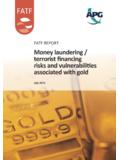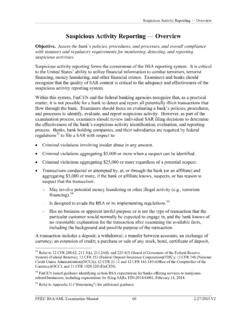Transcription of What Is Trauma?
1 1 what Is Trauma? The term psychological trauma has been applied in so many contexts byso many people that it has lost some of its original meaning. Often,traumais used to refer both to negative events that produce distress and tothe distress itself. Technically, trauma refers only to the event, not the reac-tion, and should be reserved for major events that are psychologically over-whelming for an individual. The Diagnostic and Statistical Manual of MentalDisorders,4th edition, Text Revision (DSM-IV-TR;American PsychiatricAssociation [APA], 2000) specifically defines a trauma asdirect personal experience of an event that involves actual or threatened deathor serious injury, or other threat to one s physical integrity; or witnessing anevent that involves death, injury, or a threat to the physical integrity of anotherperson.
2 Or learning about unexpected or violent death, serious harm, or threatof death or injury experienced by a family member or other close associate(Criterion A1). The person s response to the event must involve intense fear,helplessness, or horror (or in children, the response must involve disorganizedor agitated behavior) (Criterion A2). (p. 463)DSM-IV-TRprovides a list of potentially traumatic events, includingcombat, sexual and physical assault, robbery, being kidnapped, being takenhostage, terrorist attacks, torture, disasters, severe automobile accidents, andlife-threatening illnesses, as well as witnessing death or serious injury by vio-lent assault, accidents, war, or disaster.
3 Childhood sexual abuse is includedeven if it does not involve threatened or actual violence or 2/15/2006 1:39 PM Page 3 Although the DSM-IV-TRdefinition is useful, some have criticized therequirement that trauma be limited to threatened death or serious injury, orother threat to one s physical integrity, since many events may be traumaticeven if life threat or injury is not an issue (Briere, 2004). The earlier DSM-III-R(APA, 1987) definition also included threats to psychologicalintegrity asvalid forms of trauma .
4 Because DSM-IV-TRdoes not consider events to betraumatic if they are merely highly upsetting but not life threatening forexample, extreme emotional abuse , major losses or separations, degradationor humiliation, and coerced (but not physically threatened or forced) sexualexperiences it undoubtedly underestimates the extent of actual trauma inthe general population. It also reduces the availability of a stress disorderdiagnosis in some individuals who experience significant posttraumaticdistress since Criterion A is a prerequisite for the diagnosis of posttraumaticstress disorder (PTSD) or acute stress disorder (ASD).
5 The issue of whether an event has to satisfy current diagnostic definitionsof trauma in order to be, in fact, traumatic, is an ongoing source ofdiscussion in the field. Our own conclusion is that an event is traumatic if itis extremely upsetting and at least temporarily overwhelms the individual sinternal resources. This broader definition is used throughout this book, sincepeople who experience major threats to psychological integrity can suffer asmuch as those traumatized by physical injury or life threat, and can respondequally well, we believe, to trauma -focused therapies.
6 This is solely a treat-ment issue, however; the DSM-IV-TRversion of trauma should be strictlyadhered to when making a formal stress disorder Types of TraumaSurveys of the general population suggest that at least half of all adults in theUnited States have experienced at least one major traumatic stressor (Elliott,1997; Kessler, Sonnega, Bromet, Hughes, & Nelson, 1995). Although suchstressors are common, their ability to produce significant psychological dis-turbance varies as a function of a wide variety of other variables, as is dis-cussed in Chapter 2.
7 The following pages detail most of the major types oftraumatic events potentially experienced by those seeking mental health ser-vices. There are myriad ways in which an individual can be traumatized, notall of which are easily expressed in an initial clinical interview. This is impor-tant to keep in mind frequently, clients will not report events they haveexperienced unless they are specifically asked about those events in a non-judgmental, supportive context (see Chapter 3).
8 Each type of trauma is4 trauma , Effects, and 2/15/2006 1:39 PM Page 4described only briefly; the reader is referred to the Suggested Reading sectionat the end of the chapter for references to more detailed DisastersNatural disasters can be defined as large-scale, not directly human-caused,injury- or death-producing environmental events that adversely affect a signif-icant number of people. Disasters are relatively common in the United States;surveys suggest that between 13 and 30 percent of individuals have beenexposed to one or more natural disasters in their lifetimes (Briere & Elliott,2000; Green & Solomon, 1995).
9 Typical disasters include earthquakes, largefires, floods, avalanches, hurricanes, tornados, and volcanic eruptions. Theextent of physical injury, fear of death, and property loss during disastersappear to be the most traumatizing aspects of these events (Briere & Elliott,2000; Maida, Gordon, Steinberg, & Gordon, 1989; Ursano, Fullerton, &McCaughey, 1994). When mental health workers are involved in assistingdisaster victims, it is usually within the context of governmental or quasi-governmental agencies (for example, the Red Cross) that have been mobilizedrelatively soon after the event.
10 At such times, as described in Chapter 10, theclinician s initial job usually involves triage and providing support, comfort,and psychological first aid, as opposed to trauma therapy, per Interpersonal ViolenceIntentional violence that involves high numbers of injuries or casualties but does not occur in the context of war is a newer category in the traumafield. The Oklahoma City bombing on April 19, 1995 (North et al., 1999), theterrorist attacks on the World Trade Center and the Pentagon on September11, 2001 (Galea et al.)














